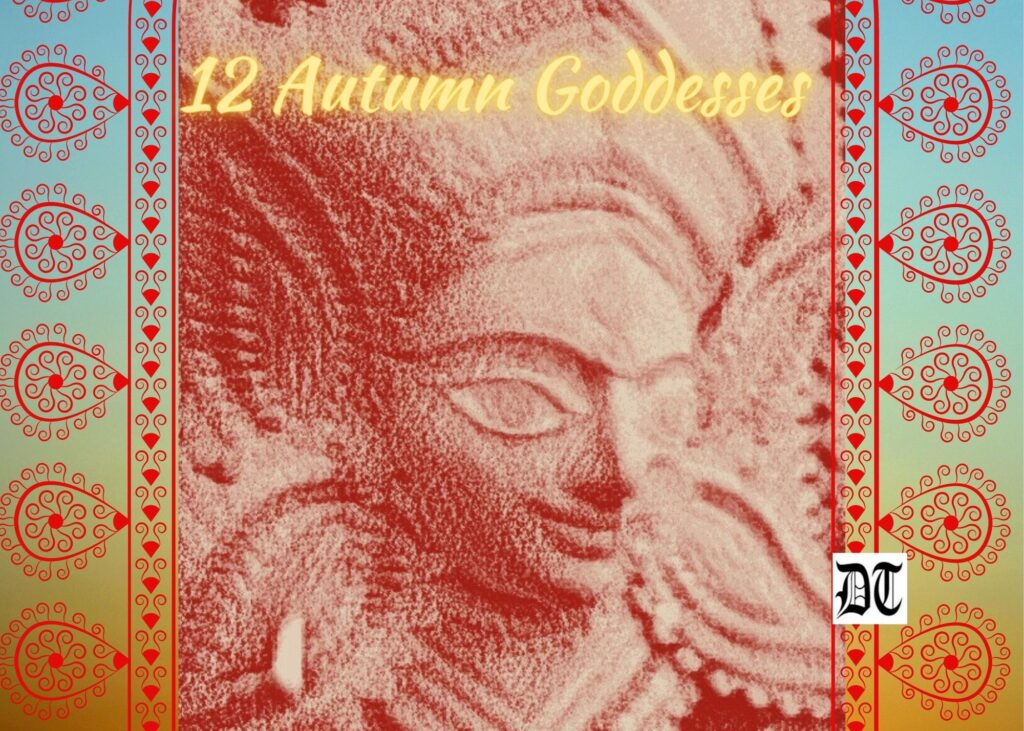Anumita takes a trip down memory lane and recalls the Lokhi (Lakshmi) puja at her Kolkata home. She tells us how the Goddess is a part of everyday discourse in Bengal. She transcends from the personal to the Universal, giving us an insight into her iconography and many forms.

“Esho Maa Lokhi bosho ghore” (Goddess Lakshmi, come and stay in my home) has been a prayer, a wish and a hope of the Grihini (Lady of the house) from time immemorial, in Bengal. Every nubile girl wishes to be addressed as ‘Lokhi’ when she enters her in-law’s home as a new bride. In a Bengali home, Lokhi is a part of everyday discourse. She forms the very matrix of our consciousness. Lokhi is, by turn, the Goddess, mother, daughter, daughter-in-law, good boy or girl (Lokhi Chele / Mey) and also a day in the week. Alokhi, however, is her opposite, often an insult, abuse or curse.
Lokhi became a part of me. My small feet were compared with the Goddess’ feet by my thakuma (granny).Wish I became a Lokhi too!
“Thakur Moshai eshe gechen, shankh bajao” (the priest has arrived blow the conch-shell). I still hear mythakuma’s voice from the distant past. My maa (mother), aunts and cousins would rush to the main door to greet the priest. One of them carried a big kolshi (pot) of water and someone else would be blowing a shankh (counch-shell). The water would be poured on the feet of the priest, before he entered the house. He had a white cloth slung around his neck, which he held in his hand. Inside the cloth was the Saligram Sila (a fossilised shell that is an anionic symbol and reminder of Vishnu).
I was visiting my parents’ home after four years. Thankuma (grandma) passed away many years ago. But it was the Lokhi Pujo (worship of Lakshmi) in the house. A feeling of belonging and loss braided itself within me.
Lokhi or Lakshmi is the considered to be the Goddess of Wealth and Prosperity. She is worshipped in most Hindu homes. As most Gods and Goddesses, her genesis is interesting. The stories have slight variations according to the geographical locations. There are some differences between the north Indian rituals, ways of presenting the Goddess, and its worship rituals in the south.
According to the Hindu scriptures, during the time of the Samudra Manthan (churning of the Cosmic Milk-sea), Goddess Lakshmi arises from the sea. She is very beautiful and is adorned with immense wealth. She is the Goddess of prosperity, divinity, health and purity. She is the consort of Lord Vishnu, as he is the only one who controls Maya (illusion). The depiction of iconography of the Goddess Lakshmi shows images with two, four, six and eight hands. She might be standing or sitting on a pink lotus. There is the presence of a white owl or elephants as a part of the iconography. Various other elements as the Amrita Kalash (Pot of Elixir), lotus, gold coins, bow and arrow, rice paddy and vermilion holder are visible in the hands of the Goddess.
The eastern part of India, West Bengal, worships Goddess Lokhi every Thursday. They call it Lokhir-baar (the day of Lokhi). I am a Ghoti, which specifies my ancestry from West Bengal, and not East Bengal, which is now Bangladesh; those hailing from there are known as Bangal. Usually in a Ghoti household there are four Lokhi Pujos in a year.
The first Lokhi Pujo is in the month of Poush, which is the ninth month of the Bengali calendar and overlaps the months of December and January in the Gregorian calendar. It is the celebration of the new harvest. A small basket make of bamboo is filled with new rice, still in its husk and used as the idol for worship. The harvest of that time like white sweet potatoes, peas and payesh (rice pudding) made of the new harvest rise are offered to the Goddess.
This is followed by the Lokhi Pujo of Chaitra or the twelfth month of the Bengali calendar. It overlaps the months of March and April. The rice in the husk, used in the previous pujo is used again. It is kept safe for the whole year for the other two pujos.
The third pujo is in the month of Bhadro, which is the sixth month of the Bengali calendar and is a merger of August and September. The following Sunday, there is Ranna Pujo or Monsha Pujo. On this day no cooking is done. All the cooking is supposed to be done the previous day and the food is not to be heated.
The final one is in the month of Kartik. It is the eighth month in the Bengali calendar and usually starts on the new moon day of November. The celebration of Kali Pujo coincides with Lokhi Pujo. This is a special pujo, in which the Alokhi (Alakshmi, the foil of Lakshmi) is sent out of the home or Alakhi Bidai. Few idols are made for this pujo. The idols are made on the outer layer of the stem, of a banana plant. Lokhi is accompanied by Narayan and Kuber.They are molded with dough made of ground rice. The white color of the rice is symbolic to purity and goodness. Alokhi is made of cow dung, its color and material symbolises the greed, strife and jealousy. This Lokhi Pujo is done in the evening, while the rest are performed in the earlier part of the morning. Before the celebration begins, Alokhi is sent out of home with due respect. A four-cornered lamp made of rice dough is lit. Some fruits and sweets are offered before sending her off. Alokhi is placed way outside the house premise. The worship of Lokhi starts after that.
There are huge symbolisms in these rituals. Wealth and prosperity brings along with it the evils of greed, avarice and jealousy. The ancient Hindu scripture says that Lokhi and Alokhi are twins. They come together. So giving due respect to each, by inviting one inside your home and sending the other out with all offerings sets the perfect balance of life.
The Hindu families originating from East Bengal (now Bangladesh) celebrate Lokhi Pujo on the first full moon night after Durga Pujo. It is called Kojagori Lokhi Pujo, as it is falls on the Kajagori Purnima (full moon). This celebration is marked by worshipping an idol of the Goddess. Some times the idol is made at home or bought from the idol-maker. It is believed that Goddess Lakshmi descends from the heavens and visits her devotees during that evening. She blesses every household, which follow her rites and rituals. The house is decked and lots of homemade sweets are offered. Lamps and lights are lit and motifs, known as alpana are made with rice paste on the floor.
Every Lokhi Pujo, no matter where in Bengal, has the motifs of the goddess’ footprints entering the home. Friends and family are invited to the festivity.
In north and south India, the popular eight forms of Goddess Lakshmi, known as Ashtha Lakshmi is worshipped. These are:
- Adi Lakshmior Maha Lakshmi is an ancient form of Lakshmi, who is believed to be the incarnation of Lakshmi as the daughter of the sage Bhrigu.
- Dhana Lakshmi is depiction for wealth (gold, money, land, etc)
- Dhanya Lakshmi is the provider of agricultural wealth, namely food grains, and represents bounty.
- Gaja Lakshmi is the provider of animal wealth, like cattle.
- Santana Lakshmi is the Goddess who blesses us with children.
- Veera Lakshmi or Dhairya Lakshmi provides valor in battles and courage and strength to overcome the many obstacles in our lives.
- Vijaya Lakshmi or Jaya Lakshmi blesses us with success, not only in battles but also for the day to day struggles of our lives.
- Vidya Lakshmi bestows knowledge of arts and sciences.

The southern states include four more forms of Lakshmi in their worship, that is, it has 12 depictions of the Goddess. These are:
- Aishwarya Lakshmi is the Goddess of riches, symbolising prosperity.
- Saubhagya is the Goddess of good fortune.
- Rajya Lakshmi is the blessed, who rules with secular power.
- Vara Lakshmi is the Goddess of boons.
It is hoped with the Goddess of wealth and prosperity residing in almost every home and business establishments, all over India, her blessings and boons are showered on one and all.
Picture adapted from calendar picture






 By
By
 By
By